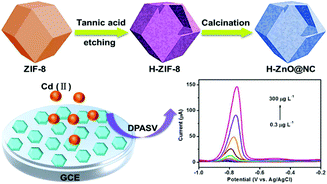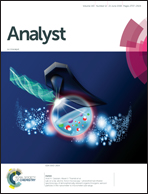In situ fabrication of hollow ZnO@NC polyhedra from ZIF-8 for the determination of trace Cd(ii)†
Abstract
In this work, a novel electrochemical sensor for Cd(II) detection with differential pulse anodic stripping voltammetry (DPASV) is fabricated based on hollow ZnO@nitrogen-doped carbon (H-ZnO@NC) polyhedra, which are prepared from ZIF-8 via in situ tannic acid etching and a subsequent calcination process. The as-obtained H-ZnO@NC exhibits a polyhedral morphology with a well-defined hollow structure and a uniform distribution of elements C, N, O, and Zn in the shell. The unique structure of H-ZnO@NC can provide an enlarged surface area and abundant active sites. Moreover, ZnO has a strong affinity for heavy metals, which can enhance the adsorption capacity of H-ZnO@NC for Cd(II) in the accumulation step of stripping voltammetry, and thus improve the electrochemical sensing performances. As expected, the H-ZnO@NC-based sensor achieves a wide linear range of 0.3–300 μg L−1, a low detection limit of 0.1 μg L−1 (S/N = 3), and exhibits good selectivity as well as high stability and reproducibility. Moreover, the proposed electrochemical sensor can be applied for the determination of Cd(II) in real water samples, obtaining satisfactory results.



 Please wait while we load your content...
Please wait while we load your content...